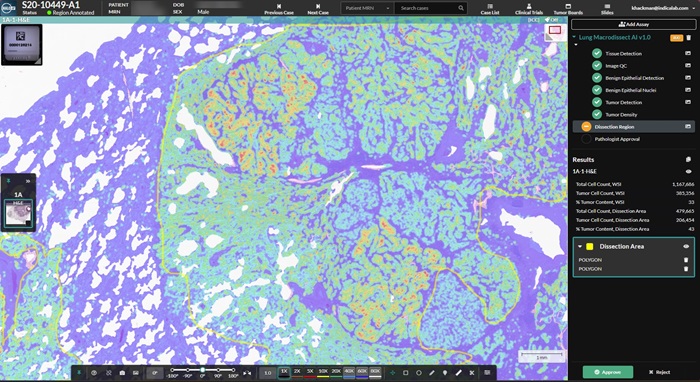Groundbreaking AI-Powered Tool Revolutionizes Slide Macrodissection and Molecular Pathology Workflows
Posted on 12 Aug 2024
Estimating tumor content and performing macrodissection are crucial processes in molecular pathology, requiring precise assessment of tumor presence in a sample and careful isolation of tumor regions for molecular analysis. Traditional manual methods are often subjective, prone to errors, labor-intensive, and lack the ability to be audited. Now, a novel tool significantly advances the integration of artificial intelligence (AI) with digital pathology by providing pathologists with an enhanced macrodissection workflow that reduces human error and boosts efficiency.
Indica Labs (Albuquerque, NM, USA) has launched Lung Macrodissect AI, a revolutionary tool that transforms slide macrodissection and molecular pathology procedures. The HALO Macrodissection Solutions suite from Indica Labs addresses existing challenges by quantifying tumor content throughout the entire slide and delivering real-time data on the number of tumor cells within annotated areas. Tumor cell density heatmaps highlight regions rich in tumor cells, assisting with accurate annotation. Lung Macrodissect AI standardizes and quantifies tumor content assessments, minimizing subjectivity and errors while simplifying the macrodissection process for both primary and metastatic non-small cell lung cancer cases. This tool is available within the HALO AP platform, known for its comprehensive suite of annotation, collaboration, and image analysis tools. HALO AP ensures seamless interoperability with various file types, LIS | LIMS, and HALO Clinical AI as well as third-party AI, offering flexibility and ease of use in diverse lab settings.

Lung Macrodissect AI can also be integrated with the Tissector line of robotic macrodissectors to create a fully automated and auditable workflow. This combination improves the accuracy of the macrodissection process, increases throughput, and enhances operational efficiency, allowing pathologists to concentrate on more complex tasks. Additionally, the tool can standardize and guide manual macrodissection workflows. In addition to identifying cancerous tissue, Lung Macrodissect AI also calculates the total number of tumor cells within an annotated region of interest (ROI) and determines the percentage of tumor presence across all annotated ROIs. This ensures that only sufficiently concentrated specimens are sent for expensive downstream genetic sequencing and molecular testing. By standardizing the enrichment process, Lung Macrodissect AI enhances the quality and reliability of macrodissection workflows while streamlining the entire process and improving efficiency.
The clinical validation of Lung Macrodissect AI was conducted on 317 primary and metastatic whole slide images from an external site that the algorithm had not previously encountered. A comparison of tumor content estimations by five pathologists, both with and without Lung Macrodissect AI, revealed significant improvements in agreement and consistency when using the AI tool. Without AI assistance, the consistency between pathologists (ICC) was relatively low at 0.45. When using a 20% tumor content cut-off for binarizing specimens, which is the minimum requirement for most molecular tests, the agreement measure (Fleiss' kappa) was also low at 0.27. However, with AI assistance, the ICC score increased to 0.75, and the Fleiss' kappa statistic rose to 0.66, indicating a significant and substantial improvement in the consistency of tumor content estimations among pathologists.
"We're excited to offer pathologists an alternative to the current time-consuming, labor-intensive process of macrodissection. Our macrodissection AI models significantly advance the field of molecular pathology," said Steven Hashagen, CEO of Indica Labs. "Lung Macrodissect AI is part of a larger suite of macrodissection tools, with additional product launches planned for colon, breast, and prostate. These products significantly enhance macrodissection workflows and make genetic testing more accessible, accurate, and affordable."
"The current manual methods of tumor content estimation and macrodissection are subjective and prone to error," said Peter Caie, Senior Principal Scientist in the AI Diagnostics group at Indica Labs. "Pathologists spend a significant amount of time meticulously examining slides and annotating regions of interest by hand, a process that is both tedious and demands immense effort on the part of laboratory staff. Lung Macrodissect AI advances the process of slide macrodissection by accurately and objectively quantifying every cell across a whole slide image, guiding and simplifying the annotation process and automatically reporting the tumor content within said annotation in real-time."
Related Links:
Indica Labs














